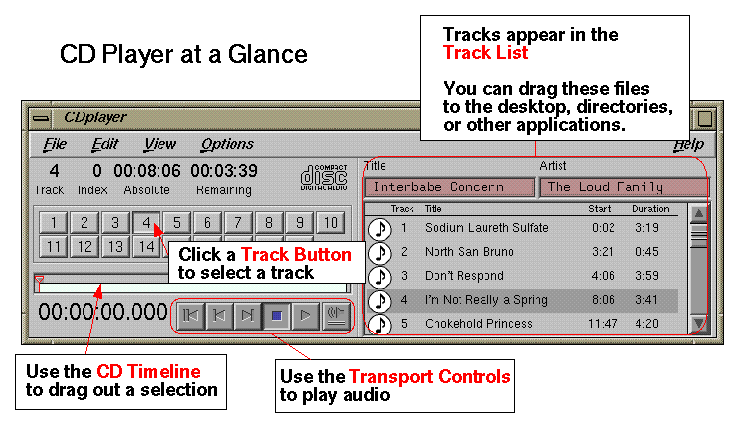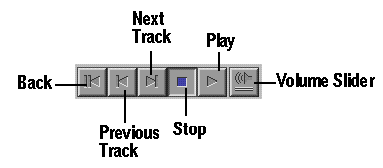This chapter includes:
This section includes:
CD Player has two primary functions for systems with SCSI CD-ROM drives:
Enables you to use your workstation to play audio compact discs (CDs).
The play controls are similar to a consumer-style CD player.
Provides convenient CD capture for audio production.
CD Player represents each track on a CD as an individual AIFF file. These files are displayed in the Track List as files you can copy to your system disk.You can also select any range of audio on the CD and save the selection as a new file.
This document follows these conventions:
Links in italics launch a term definition. For example, click: AIFF.
Red words indicate “launch links,” meaning that if you click them, they launch the tool that they name.
The symbol “>” between a menu names menu items indicates a path to a menu choice. For example, “File > Open” means “Open the File menu and choose Open.”
Three different ways to access the CD Player:
To launch it immediately, click CD Player .
To launch it by clicking on an icon:
From the desktop Toolchest, select Find > Media Tools.
Double-click the CD Player icon.
To launch it from the command line (in a UNIX shell), type: cdplayer
Insert the CD into the CD-ROM drive and launch CD Player.
Click the CD Player Play button.
Figure 7-2 points out what each transport control does. Note that when you the click Stop button, CD Player holds the stopping point. This means that when you click the Play button again, it begins playing from the point you stopped at—like a “Pause” button. To return to the beginning of the CD, click the Back button.
If the music is too soft or loud, see “Adjusting Volume.” For information about selecting certain tracks to play, see also “Moving to a Location on the CD.”
Use the Volume button (shown in Figure 7-2) to adjust volume of the CD. When you click the Volume button, a slider appears. Moving the slider up raises the volume; down lowers it.
| Note: CD Player volume operates independently of the Audio Panel volume and other applications with volume settings. |
This section includes “Capturing Audio Tracks” and “Capturing a Selected Range of Audio.” Note that capturing copyrighted material is subject to copyright laws.
Copying a CD track to your system disk is simple:
Insert the CD into the CD-ROM drive and launch CD Player.
Select the track icon from the Track List.
See “Moving to a Track” for information on locating the track. A track icon highlights in the Track List when it is selected.

Tip: You can select more than one icon at a time by holding down the Shift key while making additional selections. Drag the icon(s) to your desktop, to another application, or to an icon view.
Alternatively, you can select a track, then choose File > Save Track As... to save the track as a new file.
To save a section of a CD as a new file:
Insert the CD into the CD-ROM drive and launch CD Player.
Select a section:
Select (or re-select) by clicking and dragging out a section of the CD timeline (shown in Figure 7-1). The range of time currently selected is represented by the numbers in the bottom left corner of the CD Player window.
Make sure that Play Selection is enabled. The Play Selection command is under the Options menu.
Listen to the selected section by clicking the Play button.

Note: See “Moving to a Location on the CD” for information that may help you locate the section you want to capture. Also, “Using Play Options” describes options such as loop playback.
Choose File > Save Selection As... .
A file browser appears. Type in a name for the new file you are creating, then press the Enter key.
This section includes “Moving to a Track” and “Moving to a Specific Time.”
To advance to a specific track, just click the track number button in the track button area.
You can also use the Next Track or Previous Track buttons (shown in Figure 7-2).
| Note: Alternatively, you can select the Track number in the Track field, and type the number of the track you want, then press Enter. |
You can move to a specific time by editing the Absolute or track time fields:
The Absolute field represents the time elapsed from the beginning of the CD. For example, it would say “00:00:50” if you pressed the Stop button 50 seconds into the CD. The track time field (the larger number display in the lower left corner of the CD Player window) represents the amount of time elapsed from the beginning of the current track.
Time is presented as HH:MM:SS, where H= hours, M = minutes, and S = seconds.
To edit either of these fields, click the numbers. Then, enter a time and press Enter.
| Note: In locating a place on a CD, it can be helpful to look at the track Start and Duration fields of the Track List. Start indicates the point on the CD that the track begins, and Duration indicates how long the track is. |
Your system can digitize and play audio tracks on a CD, but it cannot read the titles of tracks on a CD. For this reason, CD Player provides a way to fill out the Track List of a CD—you need to do this only once. After the initial list is created, CD Player will recognize the CD the next time you use it, and will display the relevant track list.
To fill out the track list for a CD:
Insert the CD into the CD-ROM drive and launch CD Player.
Enter the title and artist in the Title and Artist fields.
Fill in the Track Titles—the tracks are listed in the order they appear on the CD.
To edit each Track Title field, click the field, enter a new track title, then press Enter.
| Note: Track icons in the Track List can be dragged to other locations on your system—see “Capturing Audio Tracks.” |
To set repeat playing, select Options > Repeat Options, then choose from “No Repeat,” “Repeat CD,” and “Repeat Track.”
To set a selection to play repeatedly, select Options > Loop Selection. To turn off Loop Selection, select it again. A check mark indicates it is enabled.
“Play Selection” is also under the Options menu. If you click the Play button when Play Selection is enabled, the current selection plays. A check mark indicates it is enabled.
The following sections contain overviews of CD Player features. Refer to Figure 7-1 for a diagram with feature call outs.
The CD Player menus are: “The File Menu,” “The Edit Menu,” “The View Menu,” and “The Options Menu.”
| Save Track As... |
| |
| Save Selection As... |
| |
| Eject | Ejects the CD from the CD-ROM drive. | |
| Exit | Exits program. |
| Copy Selection |
| |
| Select All | Selects the entire track. | |
| Select None | Removes any selection. | |
| Extend Selection Right |
| |
| Extend Selection Left |
|
| Headphones... | This command launches an older version of CD Player that outputs audio through the CD-ROM drive headphone port (if your CD-ROM drive has a headphone port). If you click OK, the current CD Player exits and the old version appears. Note that you can always listen to a CD using the headphone port on your workstation. | |
| Repeat Options | Offers choices for repeat playing of audio on CD. | |
| Loop Selection | If you click the Play button when Loop Selection is enabled, the current selection plays repeatedly. A check mark indicates it is enabled. | |
| Play Selection | If you click the Play button when Play Selection is enabled, the current selection plays. A check mark indicates it is enabled. |
Indicates which track is currently playing or set to play. You can edit this field to move to a different track.
If you are using a CD with indices, such as a sound effects CD, this field shows the index number of the current track.
Represents amount of time elapsed from the beginning of the CD. For example, it would say “00:00:50” if you pressed the Stop button 50 seconds into the CD. You can edit this field to move to a specific time. Time is presented as HH:MM:SS, where H= hours, M = minutes, and S = seconds.
Represents the amount of time left in the current track. You can edit this field to move to a specific time. Time is presented as HH:MM:SS, where H= hours, M = minutes, and S = seconds.
A track button is displayed for each track in the currently loaded CD—to advance to a certain track, click the number of the track you want to play.
Represents the timeline of the currently loaded CD. You can select a range of audio by clicking and dragging out a section of the timeline.
The track and selection times appear in the lower left corner of the CD Player window.
Represents the amount of time elapsed from the beginning of the current track. Time is presented as HH:MM:SS.sss, where H = hours, M = minutes, S = seconds.
Use the transport controls to play a track. See Figure 7-2.

